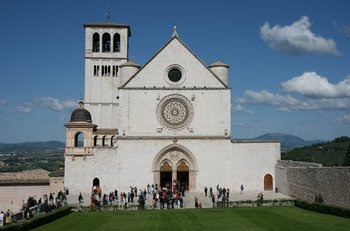 Umbria is a region of Central Italy, is a great place for a touring holiday, with picturesque hill towns, art of the highest quality, Roman and Etruscan history and some of Italy's most stunning scenery.
Umbria is a region of Central Italy, is a great place for a touring holiday, with picturesque hill towns, art of the highest quality, Roman and Etruscan history and some of Italy's most stunning scenery.Here are LoveTravel's suggestions on how to get the most out of the region, whether you're attracted by the culture, the countryside or the cusine.
Perugia is the main city of Umbria: the lively evening passeggiata in the main piazza of Umbria's vibrant capital (a university city), is not to be missed. The key buildings are the pink-and-white cathedral, begun in 1345 but not finished until 1490, the 14th-century Palazzo dei Priori, which now houses the National Gallery of Umbria, and the extraordinary Fontana Maggiore, a marble fountain with carvings by Nicola and Giovanni Pisano.
Stay at: Le Silve, a retreat in the wooded valleys east of Assisi, with high-quality apartments from 100 EUR a night.
Assisi, the huge buttresses of the hilltop Basilica di San Francesco look forbidding as you approach, but they belie the extraordinary aubtlety of Giotto's frescos of the life of St Francis on the walls inside. Arrive early to miss the coach tours, and allow a full day here: the rest of the medieval town is less crowded than the basilica and well worth exploring.

Stay at: Hotel Duomo, 15 stone-steps away from the majestic Gothic cathedral of the city.
In Spello the original Roman gates survive, but it is the steep, winding streets of this medieval town that give it so much character. Don't miss the Pintoricchio frescos in Santa Maria Maggiore.
Spoleto, has an extraordinary mix of Roman remains incorporated into much later buildings; the little church of Sant'Eufemia is one of the best examples of this. Make sure to see Lippi's frescos in the cathedral, and the vertiginous Ponte delle Torri, a bridge that spans a steep gorge on the edge of the town.
Stay at: Cavaliere Palace Hotel, in the 17th century Accoramboni della Valnerina Palace, adorned with splendid frescoes.
Todi's main square, Piazza del Popolo, is perhaps the prettiest in Umbria. Lined with medieval and Renaissance palazzi, it slopes gently upwards to the facade of the 12th-century cathedral. But you get the greatest sense of the town's long history from its three sets of tconcentric walls: they were built by Etruscan, Roman and finally medieval engineers.
Planning your trip
The most convenient way of getting to Umbria is to fly from Stansted to Perugia. Alternatively, fly to Rome from Heathrow or Gatwick and drive up the A1. There are also some good-value local car hire.
Click here for hotel booking in Umbria.




0 comments:
Post a Comment